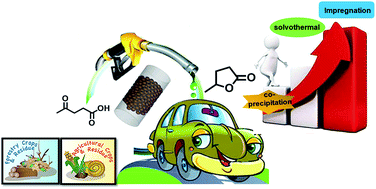当前位置:
X-MOL 学术
›
Sustain. Energy Fuels
›
论文详情
Our official English website, www.x-mol.net, welcomes your feedback! (Note: you will need to create a separate account there.)
Unraveling the structural properties and reactivity trends of Cu–Ni bimetallic nanoalloy catalysts for biomass-derived levulinic acid hydrogenation†
Sustainable Energy & Fuels ( IF 5.6 ) Pub Date : 2018-04-17 00:00:00 , DOI: 10.1039/c8se00138c Saikiran Pendem 1, 2, 3, 4 , Indranil Mondal 1, 2, 3, 4 , Abhijit Shrotri 5, 6, 7, 8 , Bolla Srinivasa Rao 1, 2, 3, 4 , Nakka Lingaiah 1, 2, 3, 4 , John Mondal 1, 2, 3, 4
Sustainable Energy & Fuels ( IF 5.6 ) Pub Date : 2018-04-17 00:00:00 , DOI: 10.1039/c8se00138c Saikiran Pendem 1, 2, 3, 4 , Indranil Mondal 1, 2, 3, 4 , Abhijit Shrotri 5, 6, 7, 8 , Bolla Srinivasa Rao 1, 2, 3, 4 , Nakka Lingaiah 1, 2, 3, 4 , John Mondal 1, 2, 3, 4
Affiliation

|
Herein, we have developed a series of silica nanosphere supported CuNi bimetallic nanoalloy catalysts via solvothermal, impregnation and co-precipitation methods and evaluated their catalytic performance for the hydrogenation of levulinic acid, a key platform molecule in many biorefinery schemes, into γ-valerolactone. Different characterization techniques including powder X-ray diffraction (PXRD), high resolution transmission electron microscopy (HR-TEM), X-ray photoelectron spectroscopy (XPS), solid state 13C CP MAS NMR, and field emission scanning electron microscopy (FE-SEM) with the corresponding elemental mapping have been employed to evaluate the compositional and structural features of the silica nanosphere encapsulated Cu–Ni bimetallic systems. The resultant catalyst asdeveloped by an impregnation method presents enhanced catalytic performance compared with other catalysts, providing 99.3% conversion of levulinic acid with 96.8% selectivity of γ-valerolactone in 13 h at 120 °C. Comparing catalytic experiments between bimetallic Cu–Ni and monometallic Cu catalysts demonstrated that the outstandingly improved catalyst activity and stability could be ascribed to the modulation of the electronic properties of the active sites and inhibition of metal particles with the introduction of another metal promoter, with good recyclability after ten recycles without notable loss in the activity. Our investigation in this study sheds light on a new insight into the structure–performance relationship of the bimetallic Cu–Ni nanoalloy phase in the low cost liquid fuel production from biomass.
中文翻译:

揭示用于生物质衍生的乙酰丙酸加氢的Cu-Ni双金属纳米合金催化剂的结构性质和反应性趋势†
本文中,我们通过溶剂热,浸渍和共沉淀方法开发了一系列二氧化硅纳米球负载的CuNi双金属纳米合金催化剂,并评估了它们对乙酰丙酸(许多生物精炼方案中的关键平台分子)加氢成γ-戊内酯的催化性能。不同的表征技术,包括粉末X射线衍射(PXRD),高分辨率透射电子显微镜(HR-TEM),X射线光电子能谱(XPS),固态13C CP MAS NMR和场发射扫描电子显微镜(FE-SEM)以及相应的元素图谱已用于评估二氧化硅纳米球包裹的Cu-Ni双金属系统的组成和结构特征。与其他催化剂相比,通过浸渍法开发的催化剂具有更高的催化性能,在120°C下13 h可提供99.3%的乙酰丙酸转化率和96.8%的γ-戊内酯选择性。比较双金属Cu-Ni和单金属Cu催化剂之间的催化实验,结果表明,引入另一种金属促进剂,可显着提高催化剂的活性和稳定性,这可归因于对活性位点电子特性的调节和对金属颗粒的抑制,十次回收后具有良好的可回收性,而活性没有明显损失。我们在这项研究中的研究为从生物质低成本液体燃料生产中双金属Cu-Ni纳米合金相的结构-性能关系提供了新的见解。
更新日期:2018-04-17
中文翻译:

揭示用于生物质衍生的乙酰丙酸加氢的Cu-Ni双金属纳米合金催化剂的结构性质和反应性趋势†
本文中,我们通过溶剂热,浸渍和共沉淀方法开发了一系列二氧化硅纳米球负载的CuNi双金属纳米合金催化剂,并评估了它们对乙酰丙酸(许多生物精炼方案中的关键平台分子)加氢成γ-戊内酯的催化性能。不同的表征技术,包括粉末X射线衍射(PXRD),高分辨率透射电子显微镜(HR-TEM),X射线光电子能谱(XPS),固态13C CP MAS NMR和场发射扫描电子显微镜(FE-SEM)以及相应的元素图谱已用于评估二氧化硅纳米球包裹的Cu-Ni双金属系统的组成和结构特征。与其他催化剂相比,通过浸渍法开发的催化剂具有更高的催化性能,在120°C下13 h可提供99.3%的乙酰丙酸转化率和96.8%的γ-戊内酯选择性。比较双金属Cu-Ni和单金属Cu催化剂之间的催化实验,结果表明,引入另一种金属促进剂,可显着提高催化剂的活性和稳定性,这可归因于对活性位点电子特性的调节和对金属颗粒的抑制,十次回收后具有良好的可回收性,而活性没有明显损失。我们在这项研究中的研究为从生物质低成本液体燃料生产中双金属Cu-Ni纳米合金相的结构-性能关系提供了新的见解。



























 京公网安备 11010802027423号
京公网安备 11010802027423号